Eloise Millar is one of the directors of Galley Beggar Press, a literary journalist, and a novelist. Aidan Semmens is a poet and a journalist, and the editor of the poetry e-zine Molly Bloom.
As it’s now the summer term, the event kicked off with four student readers. We heard Katie Szyszko reading a fragment based on a house she lived in in Hungary, Chris Scott reading a scene set in Paris at night time from the novel he’s writing for his PhD, John Wright reading poetry written in dialogue with articles by Robert Macfarlane, and David Dykes reading some poetry that he had written in a seminar taught by Simon Smith. You can read all of this work in the summer reading series booklets, available at the reading series every week — do buy one!
The summer term reading series events are about the publishing industry, and so while both Eloise and Aidan are published writers, they were here in their capacity as publishers and editors.
Molly Bloom is an online poetry magazine that Aidan says is pretty much in ‘the modernist tradition’ — which doesn’t mean that everything he publishes has to be explicitly modernist. But it is a tradition, or a general area of poetry, that he’s interested in. That he likes. The magazine is a reincarnation of a print magazine that Aidan published in 1980, shortly after leaving Cambridge. He set the website up three years ago after being persuaded to recreate it online — he could reach a much wider readership. “Poetry is a niche within a niche,” Aidan says, and finding the readership for the print magazine had been difficult. Online, it’s much easier.
Galley Beggar was set up in 2012, Eloise tells us, by three people — her, Sam Jordison, and Henry Layte (who is no longer involved; he runs The Book Hive in Norwich). She says that they’d been meeting in Henry’s bookshop for a year, “arrogantly moaning” about publishing — about ugly books, and about how it felt that writers they liked weren’t able to get published, or weren’t selling so well, which would then stop them from being able to publish their work. They have eclectic tastes, and the books they wanted to see were often considered maybe too experimental, too left-field. And then one day, she says, they decided — let’s do this! Henry’s godfather, Simon Gough, had written a fictionalised book about his great-uncle — Robert Graves. It had been commissioned as a drama by the BBC as a drama, but when they dropped it, he turned it into a novel. He had been working on it for 25 years. So they took it on — it was their first book. It was a process of learning very quickly. They’ve now published a number of books, including the multi-award-winning A Girl is a Half-Formed Thing, by recent guest to UoK Eimear McBride! Eloise says that like Molly Bloom, Galley Beggar is also interested in publishing works that fit into a modernist tradition, with their authors Eimear McBride and Alex Phelby as key examples.
Amy asks if it’s been difficult for them to publish works that are modernist and/or experimental, and why they think they’re not being more widely published. Eloise says that at Galley Beggar they can publish what they fancy, and with Eimear and Alex their work is definitely modernist, with a real focus on interiority, but both have done well. Aidan says that poetry doesn’t sell — nobody is in it for the money, and so he’s able to publish what he wants, too, without worrying about what is financially viable. The project is about him working out what he likes on his own, without external/monetary pressure.
Next they talked about how they promote the work they publish. Aidan says that he uses Facebook to connect with writers, and that his network is always expanding there. Facebook is also his prime means of distribution. In 1980 it cost £400 to produce a single issue in print, even as cheaply made as possible. Now he can reach people for a fraction of the cost.
Eloise says that at Galley Beggar they publish 2-4 writers in print books a year — they couldn’t manage more books than that. But Sam thought up their Singles Club short stories and subscription package, that allows them to publish one short story a month as an ebook. These tend to be small pieces of work by new writers, giving them a platform. They’re for sale online, and they go to a few hundred subscribers. They had a headstart with publicising their books because of Sam’s contacts (Sam works as a literary journalist at The Guardian and elsewhere), and their skills from publishing — the networking really helps. The book trade is the only industry where stock can be returned up to 18 months later. So Waterstone’s might order 800 books but send 600 back — which is really difficult and dangerous for small presses. So they have to do their best to survive. Eloise deals with the production side of the books herself — she talks to the typesetter, printer and distributor directly. She has a database with literary journalists in and a good sense of what everyone likes, what’s been reviewed lately etc., so they can email people individually about their upcoming titles. This allows them to ask for feedback, and knowledge of what’s happening. They go to events, and meetups with other small publishers too. “If you run a small press you’ve got to be a jack of all trades!”
The first issue of Molly Bloom was entirely made up of writers that Aidan had invited to submit poems to him, but the proportion of solicited to unsolicited works that he publishes is changing with time. The website says that he’s open to submissions, and he’s slowly getting more and more sent to him without having to ask otherwise. He says that the next issue he publishes will be the first to be entirely made up of work that he came across in this way. Because it’s not about money, he can just take what he likes, and what fits the magazine — he says he does get some submissions that are well-written that he doesn’t take just because he can’t see the point in what they’re doing.
Galley Beggar used to have manuscript submissions open online, but Eloise says that it was too overwhelming — they’d be sent around 200 manuscripts a week. They had to find a third reader, but even then it was just too much to get through. So they’ll move to a system where they have short reading windows — that way they can still receive unsolicited manuscripts, but it’ll be easier to manage. They’ve got a book upcoming from a UoK alumnus (Gonzalo! A former writer of this blog!) who was shortlisted for their recent short story prize, and they’re working closely with another writer from the shortlist too. They only publish work that they love — they need to have a lot of passion and interest to get through the process. “We know it when it arrives,” Eloise says. This passion hopefully follows the book through the whole process — Eloise says that independent publishing isn’t likely to make a lot of money, but they do get attention from people who really care about the work. Larger publishers are great too, but they’re up against a lot — smaller presses can maybe take more risks. Aidan says that poetry publishing has now often moved to PoD, but Eloise says that Galley Beggar use litho printing and have books stored in a warehouse; this is a key difference between poetry and fiction. It’s good to have a number of books printed at once — better margins, and the books are readily available if they’re suddenly needed.
The best part, for Aidan, is when he receives a great new poem by someone he hadn’t heard of before (although he stresses that it’s also good to get poetry from people he does know!); he doesn’t like reading a lot of the poetry that’s out there, but he does like the poetry that gets sent to Molly Bloom.
Eloise’s favourite part of the process is watching a book come together over the editorial process — and then hopefully receiving good reviews, and awards nominations! So many of their authors have previously been rejected from bigger presses for commercial reasons, so it’s really great to see them selling well.
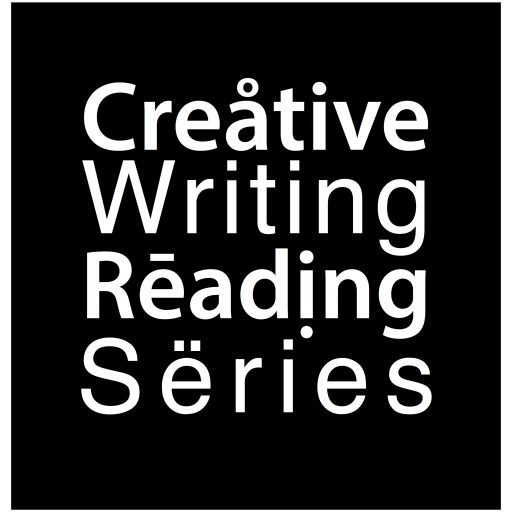

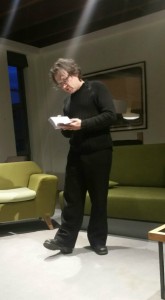
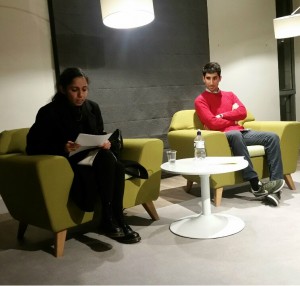

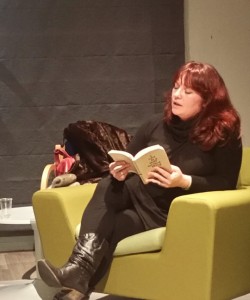
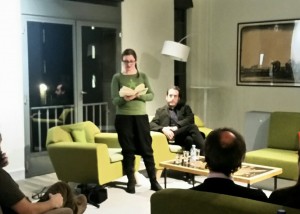



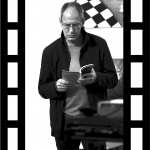



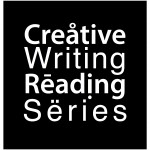
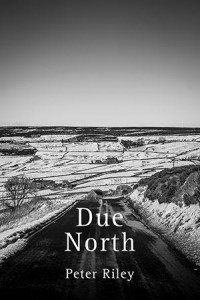 Due North, a fascinating collection of philosophical landscape poems that present the reader with a series of images
Due North, a fascinating collection of philosophical landscape poems that present the reader with a series of images